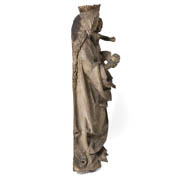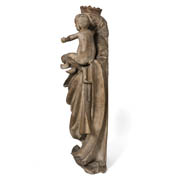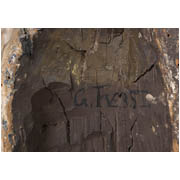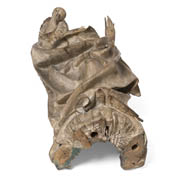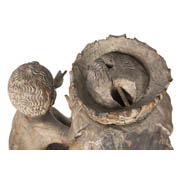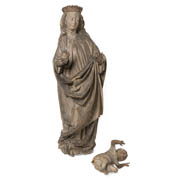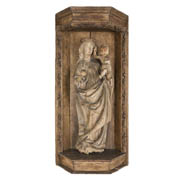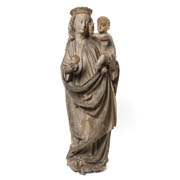Details
- Object type
figure
- Title
Virgin Mary and Christ Child
- Place Associated
Germany, Swabia, possibly (place of manufacture) or Germany, Upper Rhineland, possibly (place of manufacture)
- Date
circa 1440-1460
- Materials
limewood wood, traces of ground, traces of polychromy
- Dimensions
overall: 1155 mm x 410 mm x 310 mm 19650 g
- Description
-
Full figure limewood sculpture of the Virgin and Child. The Virgin wears a plain long gown which is tied at the neck. Over the gown she wears a heavy mantle which is brought over her left arm and falls across her front in swag-like folds. Her long hair flows from below a partial veil and crown, and she stands upon the face of a crescent moon (the arms of the crescent are missing). In her right hand she holds an apple, with the Christ Child in her left arm. The figure of Christ (50.11.1) is constructed separately from the Virgin and fixed via wooden dowels. He is naked, with his legs crossed and his right arm raised in benediction. The figure is possibly of a later date. The back of the Virgin is hollowed out, as is common in freestanding wooden figures. The removal of the heartwood not only reduced the weight of the sculpture but helped prevent future cracking and splitting of the wood. A hole in the top of the Virgin’s head would originally have been fitted with a dowel, used by the sculptor to fix and stabilise the roughly shaped wooden block horizontally on to a workbench for carving. The surface retains faint traces of polychromy.
The use of limewood is typical of southern German figurative sculpture. Stylistically the carving compares well with works of Swabia and the Upper Rhine, particularly around the rounded soft face and high forehead of the Virgin.
The iconography of this piece, with the faced crescent moon at the feet of the Virgin was prevalent in Virgin and Child groups of fifteenth century Germany. The moon is presented in reference to the Vision of St John (Book of Revelation (21:1)), in which ‘A woman clothed with the sun, and the moon at her feet’, was central to the ushering in of the Apocalypse and the Second Coming of Christ. This figure was widely identified as the Virgin in medieval theology.
Provenance: Purchased by Sir William from K J Hewitt Limited, London, 8th June 1955. Sir William’s friend and art dealer, John Hunt, wrote of the piece ‘it is a wonderful thing and the finest sculpture that has turned up in England for years’.
- Credit Line/Donor
Gifted by Sir William and Lady Burrell to the City of Glasgow, 1944
- Collection
Burrell Collection: Wood Carvings
- ID Number
50.11
- Location
Burrell Collection


